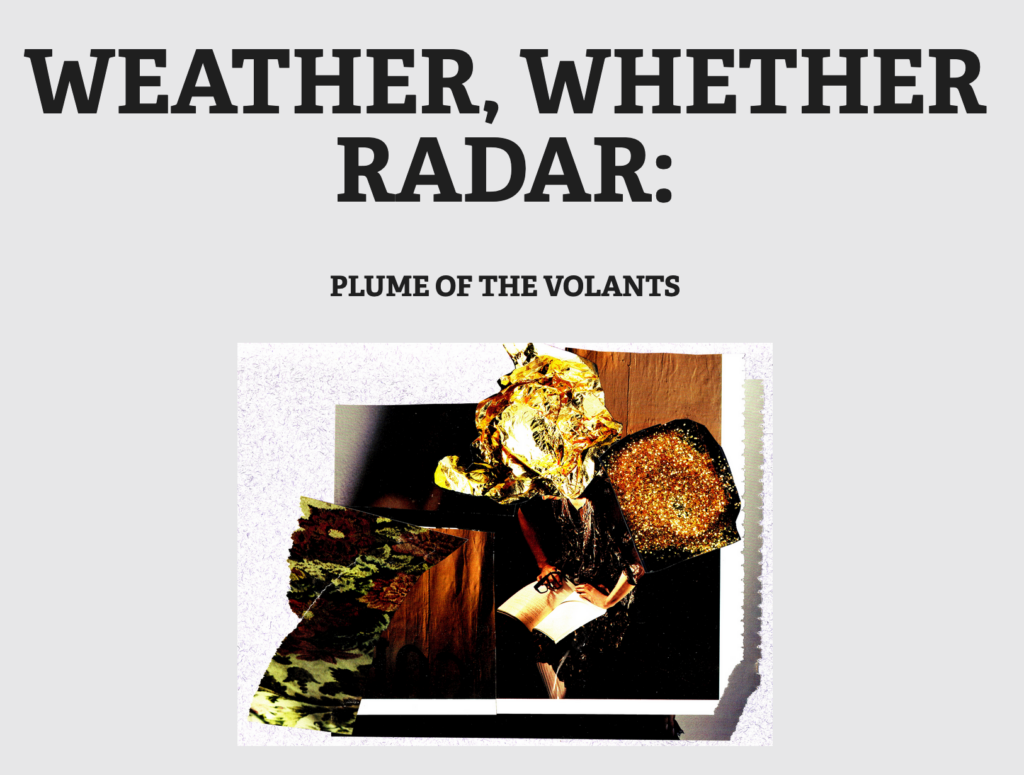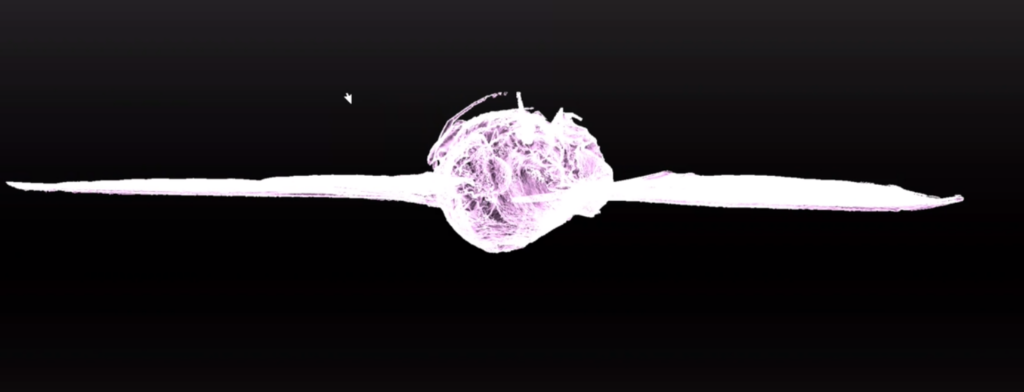
A digital studio, a portfolio of works made following the award of the Dare Prize 2020/1 . The project has evolved through conversation, and in collaboration with the University of Leeds, Biodar researchers and Opera North and in association with the National Science and Media Museum and The Tetley, Leeds.
The project offers a poetic, creative-critical and visual engagement with the current research themes of the BioDAR group at the University of Leeds. Biodar summarise their project as concerned with the reinterpretation and appropriation of weather data for purposes of measuring biodiversity:“Weather radar scan the entirety of the UK every 5 minutes, and similar types of radar are used around the world for the same purpose. These radars routinely detect insects, but since animals are not of interest to meteorologists, they are discarded as unwanted “noise”. That “noise” is a veritable treasure trove of information on insect diversity and abundance, but what is required is a way to link what a radar sees to the insects that we wish to monitor.” BioDAR Research Team, University of Leeds.
*Previously discarded by weather scientists, the data collected by weather radar is hugely valuable in the mapping of insect life. Information about insects and other animals in the sky is a by-product of the UK’s extensive weather radar network which can now be reinterpreted and put to more extensive uses in the mapping of species diversity.
The BioDAR team at Leeds are developing ways to recognise and measure different species of insects in the skies using this data, employing 3D modelling and academic expertise from the fields of biology, ecology, physics and atmospheric science.This project has attempted to engage with scientific research practice alongside the development of work that considers how to frame related ecological, historical and cultural concerns through poetics and visual practice. The representation of insects, species diversity and environmental crisis are considered alongside parallel diversions into noise as considered in the expanded frames of music, art and culture, including the politics of a ‘discarded noise’ that enframes the cultural and social marginalisation of certain groups.
The project considers how this enframing can be related to economic and social histories of power and control and attempts to explore how a practice-based visual poetics might respond.The project is concerned to highlight how these alternate histories of noticing, reading and quantification are not without their own complexities and points of tension: radar, for example, is developed out of the technological developments of warfare. The methodology of the BioDar scientists has been to invert the trajectory of this scientific history and repurpose the technology of radar for alternative readings that raise possibility and hope for future mappings of biodiversity rather than war. This project finds parallels between such re-readings and other long term failures to make account for and to interpret data, such as the lack of action in response to the data of climate change and environmental degradation. Fragile points of correspondence and narrative have been tracked and imagined through the objects and figures represented in the collections at the National Science and Media Museum and related archives.
To date, under lock down, the project is figured in relation to the possibilties of a digital studio. In this format the digital studio has been a place to explore and ‘house’ concerns associated with the reading of ‘noise’, insects, radar, enviromental crisis, climate change and environmental degradation. It has done this by constructing new paths of attention to a variety of source materials across a range of media.
Future iterations might explore gallery, live and book based formats. The digital studio as presented is an ephemeral container and incubator that will not limit the future possibilities of the texts presented here. Historical points of correspondence have been explored in poetic, visual and narrative driven texts that draw on research into these and related areas in science, film, art and music.
The singer, Matthew Stiff and the chorus at Opera North have also recorded versions of ‘Proposals and Fragments for Opera’ . The prevailing fragility of the forms chosen: partial narratives, poetic texts, visual collage, are also fragmentary, and, in terms of their cultural capital as formal entities, might be considered equally dismissable as mere ‘noise’.The project has evolved under the restrictions of the 2020/21 lockdown and as such the ideas of “remote sensing” have taken on a poignancy that extends beyond its use as a term that might relate only to scientific inquiry. These and other extensions are explored throughout and in particular in the sequence entitled Diapause.The limitations and reach of the work in this digital studio have taken shape alongside the emergence of key world events, not least the end of the Trump presidency, the aftermath of the shooting of George Floyd and the rise of the Black Lives Matter movement.
The project has attempted to remain permeable and responsive to world events and has sought to approach them through the lens provided by the project as a whole. https://weatherwhetherradar.art/

Link to selected works
https://weatherwhetherradar.art/fragments-for-an-interspecies-opera
You can read a collection of writings from the project here
